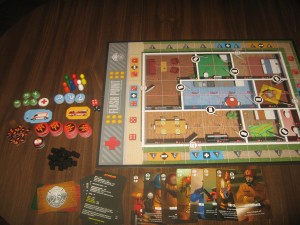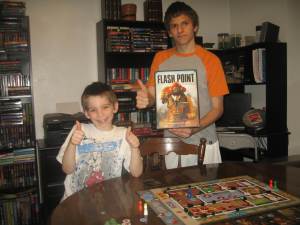I have to admit, being a policeman or a fireman was always appealing to me as a kid. It didn’t help that I was the smallest kid in the universe, but I still found the idea of making a difference to be quite appealing. People who risk their lives every day are to be commended for their dedication and service to their fellow-man. It turns out that I was better at calculating “X” than I was doing push ups in gym class…hence why I took up accounting as opposed to something more physically demanding. To that end, I found great pleasure in discovering and purchasing this little gem and unpackaging the components in front of the kids. My eleven year old son looked at the box excitedly and asked, “Do you get to save people in this?” to which I replied proudly, “Yep.”
*Note: I am fairly sure that anyone with an imagination could play solo, taking on the role of two player tokens at once or some variant like that. Feel free to experiment.
Okay, so we’re not saving real people, but Flash Point: Fire Rescue has a great theme. Players take on the role of firemen that are trying to rescue victims from a burning house. You and your friends will be working cooperatively to rescue seven victims before a number of game ending conditions occur. There are a lot of similarities to Pandemic in that regard…that is…you’ll be working together to avoid catastrophe, spreading danger each turn, and giving high-fives all around when you collectively beat the game by the skin of your teeth.
The board is two-sided, giving players a bit of variety so that they aren’t stuck with the same old layout each game. The game comes with two dice, one being a red six-sided die and the other a black eight sided die. Pictures of the numbers representing the red sided die are listed on the sides of the board and pictures of the numbers representing the black sided die are listed along the top and bottom of the board. When both dice are rolled for various reasons, you simply match up the horizontal and vertical coordinate and take the action in that particular spot.
There are also multiple modes of play, including a family friendly version that simplifies rules and cuts out some of the features and an experienced version that can be just as easy or as hard as you want it to be. Vinnie Jr, Anthony Jr, and I opted for the easiest difficulty level using the experienced rule set. The family version cut out role cards which is something I knew both of them really wanted to try out, so I took a chance and hoped for the best. Please keep this in mind when reading the review as I’ll be covering ALL of the features and not just those found in the family rules version.
Before I get into the game itself, it’s important to understand a few of the components and some of the key game mechanics.
Components & Game Mechanics
Smoke / Fire Tokens: One side of the token is smoke, the other is fire. Throughout the game, players will be rolling both dice to place smoke at the coordinate the dice point to. The result of this event depends on what is in that square already. Placing smoke on a smoke token turns it into fire and placing smoke on fire causes an explosion, just to name a few examples. If fire ever resolves near smoke, that smoke token will automatically be flipped to fire. Having a bunch of smoke tokens near each other is a recipe for disaster.
Explosions: Explosions often result when a player rolls for smoke (roll for smoke…where else can I say that?) and the result ends up being on a square already occupied by fire. There are other situations where explosions can occur, such as smoke turning into fire on a square occupied by a hazmat token. During an explosion, fire is placed in all adjacent spaces. Should an explosion strike a wall, a damage marker is placed on the wall. Should an explosion strike a space already occupied by fire, you’d move the new fire token along that path until it came to either a wall or an open space, whichever comes first.
Damage Markers: A number of damage cubes are available off the board. Throughout the game, walls will become damaged, either by explosions or by the players themselves via chopping. If the supply of damage markers ever runs out, the house collapses and the victory conditions are checked. It takes two damage markers to destroy a wall, though players are able to move through these sections to aid them in getting around the house easier. Players can spend action points to chop walls, however, this draws damage markers from the supply. Players should be cautious when using this action / ability.
Hot Spot Tokens: Whenever people roll for smoke (I love saying that) and the dice tells them to place a smoke token on a space with a hot spot token, the smoke is resolved as normal and the player rolls AGAIN to place another smoke token. Hot spots represent areas of the house more susceptible to catching fire.
Hazmat Tokens: These are randomly placed on the board at the beginning of the game. Should a fire token ever be resolved on a space with a hazmat token, an explosion occurs.
The Ambulance / Fire Truck: Around the outside of the building are four spaces for the ambulance and fire truck, one for each side of the building. Players will be able to make use of these vehicles in various ways and move them around the building to locations where they are needed.
Role Cards: There are a number of roles players can pick from which provide them with unique, special abilities. Some role cards allow players to take three free extinguish action point moves while others heal victims, reducing the movement penalty when taking them out of the house. Roles can be switched out at the fire truck at the cost of action points.
Point of Interest Tokens: Point of interest tokens are either victims or false alarms. Players will need to investigate these spaces / tokens to know which is which. Three are randomly scattered in the beginning of the game and new POI’s are randomly seeded as others become resolved.
Action Points: Players have set number of action points to use on their turn, as indicated by the role card they currently have. Different actions have different action point costs. Players can save their action points up if they wish so that they have extra for a future turn, though there is a limit to how many action points you can que up.
Those who are overwhelmed at this point should keep in mind that the family version of the rules eliminates a lot of the above features, making the game a lot more simpler to follow. After a couple of playthrus, players who were hesitant at first might be confident enough to tackle the experienced version if they so wished to.
Board Setup & Play
First, the board is set up in various ways. I won’t rehash what’s already in the manual, but you’ll be rolling to place initial fire tokens and their resulting explosions, hot spots, points of interest, hazmat tokens, and the like. Role cards are distributed (either randomly or by agreeing on them) and players place their tokens on one of the outside spaces, usually next to a door.
Once the board is set up, players take turns performing the following functions:
1) Spend Action Points
2) Roll for Smoke & Resolve Smoke / Fire / Explosions
3) Roll for Points Of Interests (If Appropriate)
Turns go by pretty quick once you get the hang of step two. The nuances of figuring out when and where to place fire or damage markers after an explosion was probably the toughest game mechanic we had to learn. After our fifth explosion however, we were almost instantly able to say, “fire goes here, fire goes here, oh there’s a wall so damage goes there…etc etc etc.”
Winning / Losing
Winning: You win after rescuing your seventh victim.
Losing: You lose when four or more victims are lost to the fire.
In the event of a building collapse, POI markers inside the house are automatically lost. This usually results in a loss.
The Review
Overall, the game took us about an hour to play. Readers should keep in mind that we played the experienced game and it was our first time. We defeated the board with three damage markers remaining and only lost one victim.
Vinnie Jr, the eleven year old, enjoyed taking on the role of the “Driver” who can shoot the fire truck’s deck gun for only two APs instead of four APs. I have to admit, that really came in handy. The deck gun can extinguish a couple of spaces with fire straight away, depending on your luck with the dice. Initially, he started out as the ”Imaging Technician” so that he could reveal points of interest quickly, we didn’t have enough fires on the board yet to warrant use of the fire truck’s deck gun. Revealing POI’s early on helped save us APs…that is…by allowing us to go after the actual victims instead of chasing false alarms.
I spent the majority of the game playing as the “CAFS Firefighter”, which gave me three free APs to extinguish smoke and fires. I stayed in the thick of things, trying to get rid of the smoke and fire as to reduce the likelihood of an explosion.
Anthony Jr played as the “Fire Captain” who got to use two free APs to move someone else on his turn. This helped me out a great deal as my character, while great for extinguishing, was limited to three actual APs a turn instead of the usual four.
All three of us enjoyed the game, mainly for its cooperative play and for the whole “saving people” theme. When explosions occurred, they were anxious to see how it played out and how it would affect the rest of the board and the POIs they were going after.
I appreciate the fact that they included a family version of the rules for those that aren’t into games all that much. The family version would also help someone new to the game to learn it without being overwhelmed by the more “complex” game mechanics.
If you liked Pandemic, or any other cooperative game for that matter, then I recommend looking into this one.
Final Verdict: 8/10



